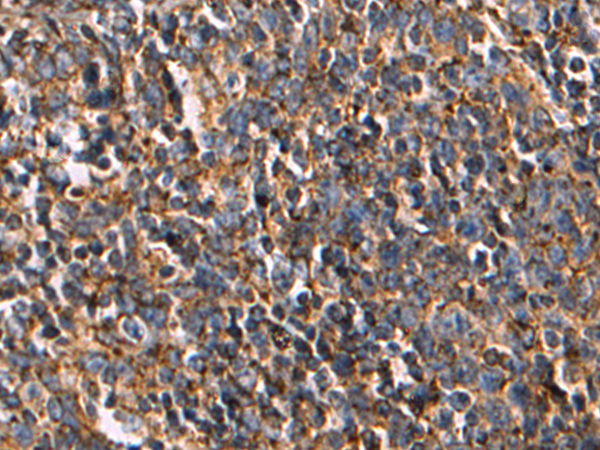
| WB | 咨询技术 | Human,Mouse,Rat |
| IF | 咨询技术 | Human,Mouse,Rat |
| IHC | 1/50-1/200 | Human,Mouse,Rat |
| ICC | 技术咨询 | Human,Mouse,Rat |
| FCM | 咨询技术 | Human,Mouse,Rat |
| Elisa | 1/5000-1/10000 | Human,Mouse,Rat |
| Aliases | LAMPA; CD107a; LGP120 |
| Host/Isotype | Rabbit IgG |
| Antibody Type | Primary antibody |
| Storage | Store at 4°C short term. Aliquot and store at -20°C long term. Avoid freeze/thaw cycles. |
| Species Reactivity | Human |
| Immunogen | Synthetic peptide of human LAMP1 |
| Formulation | Purified antibody in PBS with 0.05% sodium azide and 50% glycerol. |
+ +
以下是3篇涉及LAMP1抗体的研究文献摘要概括(基于公开文献库信息整理):
---
1. **文献名称**: *LAMP1 regulates lysosomal cholesterol efflux and neutral lipid homeostasis*
**作者**: Schulze et al. (2020)
**摘要**: 研究利用LAMP1抗体进行免疫荧光和蛋白质印迹,发现LAMP1通过调控溶酶体胆固醇转运影响细胞脂质代谢,缺失LAMP1导致溶酶体胆固醇蓄积和中性脂质合成异常。
---
2. **文献名称**: *Lysosomal positioning coordinates cellular nutrient responses*
**作者**: Xu et al. (2016)
**摘要**: 通过LAMP1抗体标记溶酶体定位,研究揭示溶酶体在细胞内的空间分布变化与mTORC1信号通路的关系,证明溶酶体动态定位对营养感知至关重要。
---
3. **文献名称**: *LAMP1 is a biomarker for aging-related lysosomal dysfunction*
**作者**: Cortes et al. (2018)
**摘要**: 采用LAMP1抗体分析老年小鼠组织样本,发现LAMP1表达水平与溶酶体膜稳定性及自噬功能退化相关,提示其可作为衰老过程中溶酶体功能障碍的标志物。
---
如需具体文献DOI或更详细引用格式,建议通过PubMed或Google Scholar搜索标题或作者进一步获取。
LAMP1 (lysosomal-associated membrane protein 1) is a transmembrane glycoprotein predominantly localized to the lysosomal membrane, playing critical roles in lysosomal biogenesis, autophagy, and cellular waste degradation. As a member of the LAMP family, it consists of two luminal domains connected by a hinge region, heavily glycosylated to protect lysosomal membranes from enzymatic degradation. LAMP1 antibodies are widely used tools in cell biology and biomedical research to study lysosomal dynamics, organelle integrity, and disease mechanisms.
These antibodies specifically recognize epitopes on the LAMP1 protein, often targeting its luminal domain due to high immunogenicity. They are produced in various host species (e.g., rabbit, mouse) using immunogens like recombinant proteins or synthetic peptides. Applications include immunofluorescence, Western blotting, and immunohistochemistry to visualize lysosomal distribution, monitor autophagy flux, or investigate lysosomal dysfunction in cancers, neurodegenerative disorders (e.g., Alzheimer’s), and lysosomal storage diseases.
Commercial LAMP1 antibodies may vary in clonality (monoclonal/polyclonal), epitope specificity, and cross-reactivity across species (human, mouse, rat). Validation is essential, as nonspecific binding can occur due to homology with LAMP2. Research using LAMP1 antibodies has advanced understanding of cellular homeostasis, pathogen invasion mechanisms (e.g., viruses exploiting lysosomes), and therapeutic targeting of lysosomal pathways.
×